Introduction to Marketing Report: Shangri-La Hotels, Semester 2, 2019
VerifiedAdded on 2022/10/31
|7
|1902
|76
Report
AI Summary
This report provides a comprehensive marketing analysis of Shangri-La Hotels and Resorts, examining the micro and macro environmental forces that influence its operations. The micro forces include suppliers, customers, competitors, and market intermediaries, while the macro forces encompass socio-cultural, environmental, and technological factors. The analysis highlights the significance of customer relationships, supplier dominance, and competitive strategies in the hotel industry. The report delves into the socio-cultural aspects of the Australian market, emphasizing the need for culturally diverse offerings and health-conscious options. It also addresses environmental trends and the importance of sustainability. Based on the analysis, the report offers recommendations for Shangri-La Hotels, including providing personalized customer experiences, leveraging technological advancements, adopting competitive advantage strategies, and increasing the environmental focus. These recommendations aim to enhance customer loyalty, improve operational efficiency, and ensure long-term profitability in the competitive hospitality market. The report concludes by summarizing the key findings and emphasizing the importance of adapting to the dynamic business environment.
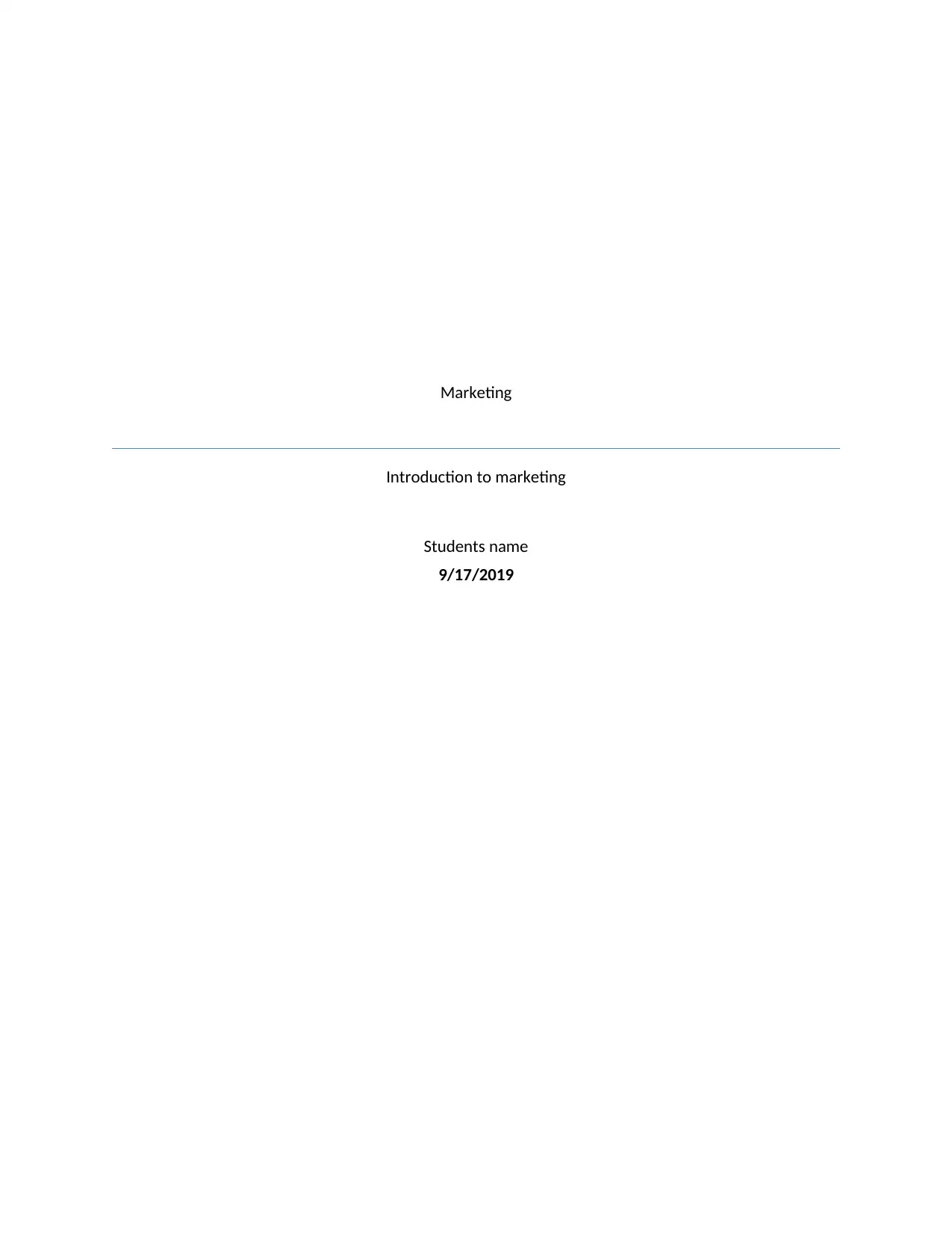
Marketing
Introduction to marketing
Students name
9/17/2019
Introduction to marketing
Students name
9/17/2019
Paraphrase This Document
Need a fresh take? Get an instant paraphrase of this document with our AI Paraphraser
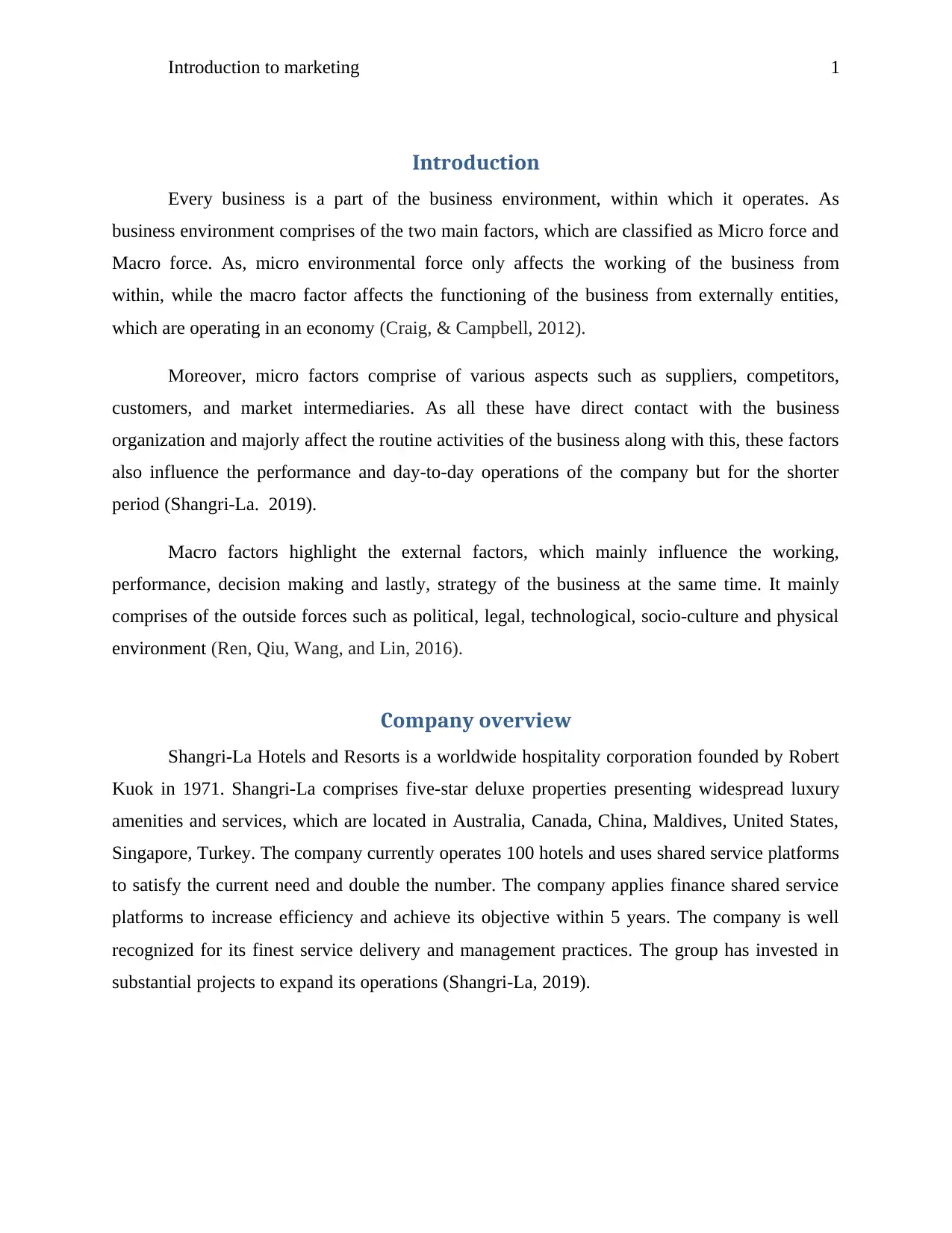
Introduction to marketing 1
Introduction
Every business is a part of the business environment, within which it operates. As
business environment comprises of the two main factors, which are classified as Micro force and
Macro force. As, micro environmental force only affects the working of the business from
within, while the macro factor affects the functioning of the business from externally entities,
which are operating in an economy (Craig, & Campbell, 2012).
Moreover, micro factors comprise of various aspects such as suppliers, competitors,
customers, and market intermediaries. As all these have direct contact with the business
organization and majorly affect the routine activities of the business along with this, these factors
also influence the performance and day-to-day operations of the company but for the shorter
period (Shangri-La. 2019).
Macro factors highlight the external factors, which mainly influence the working,
performance, decision making and lastly, strategy of the business at the same time. It mainly
comprises of the outside forces such as political, legal, technological, socio-culture and physical
environment (Ren, Qiu, Wang, and Lin, 2016).
Company overview
Shangri-La Hotels and Resorts is a worldwide hospitality corporation founded by Robert
Kuok in 1971. Shangri-La comprises five-star deluxe properties presenting widespread luxury
amenities and services, which are located in Australia, Canada, China, Maldives, United States,
Singapore, Turkey. The company currently operates 100 hotels and uses shared service platforms
to satisfy the current need and double the number. The company applies finance shared service
platforms to increase efficiency and achieve its objective within 5 years. The company is well
recognized for its finest service delivery and management practices. The group has invested in
substantial projects to expand its operations (Shangri-La, 2019).
Introduction
Every business is a part of the business environment, within which it operates. As
business environment comprises of the two main factors, which are classified as Micro force and
Macro force. As, micro environmental force only affects the working of the business from
within, while the macro factor affects the functioning of the business from externally entities,
which are operating in an economy (Craig, & Campbell, 2012).
Moreover, micro factors comprise of various aspects such as suppliers, competitors,
customers, and market intermediaries. As all these have direct contact with the business
organization and majorly affect the routine activities of the business along with this, these factors
also influence the performance and day-to-day operations of the company but for the shorter
period (Shangri-La. 2019).
Macro factors highlight the external factors, which mainly influence the working,
performance, decision making and lastly, strategy of the business at the same time. It mainly
comprises of the outside forces such as political, legal, technological, socio-culture and physical
environment (Ren, Qiu, Wang, and Lin, 2016).
Company overview
Shangri-La Hotels and Resorts is a worldwide hospitality corporation founded by Robert
Kuok in 1971. Shangri-La comprises five-star deluxe properties presenting widespread luxury
amenities and services, which are located in Australia, Canada, China, Maldives, United States,
Singapore, Turkey. The company currently operates 100 hotels and uses shared service platforms
to satisfy the current need and double the number. The company applies finance shared service
platforms to increase efficiency and achieve its objective within 5 years. The company is well
recognized for its finest service delivery and management practices. The group has invested in
substantial projects to expand its operations (Shangri-La, 2019).
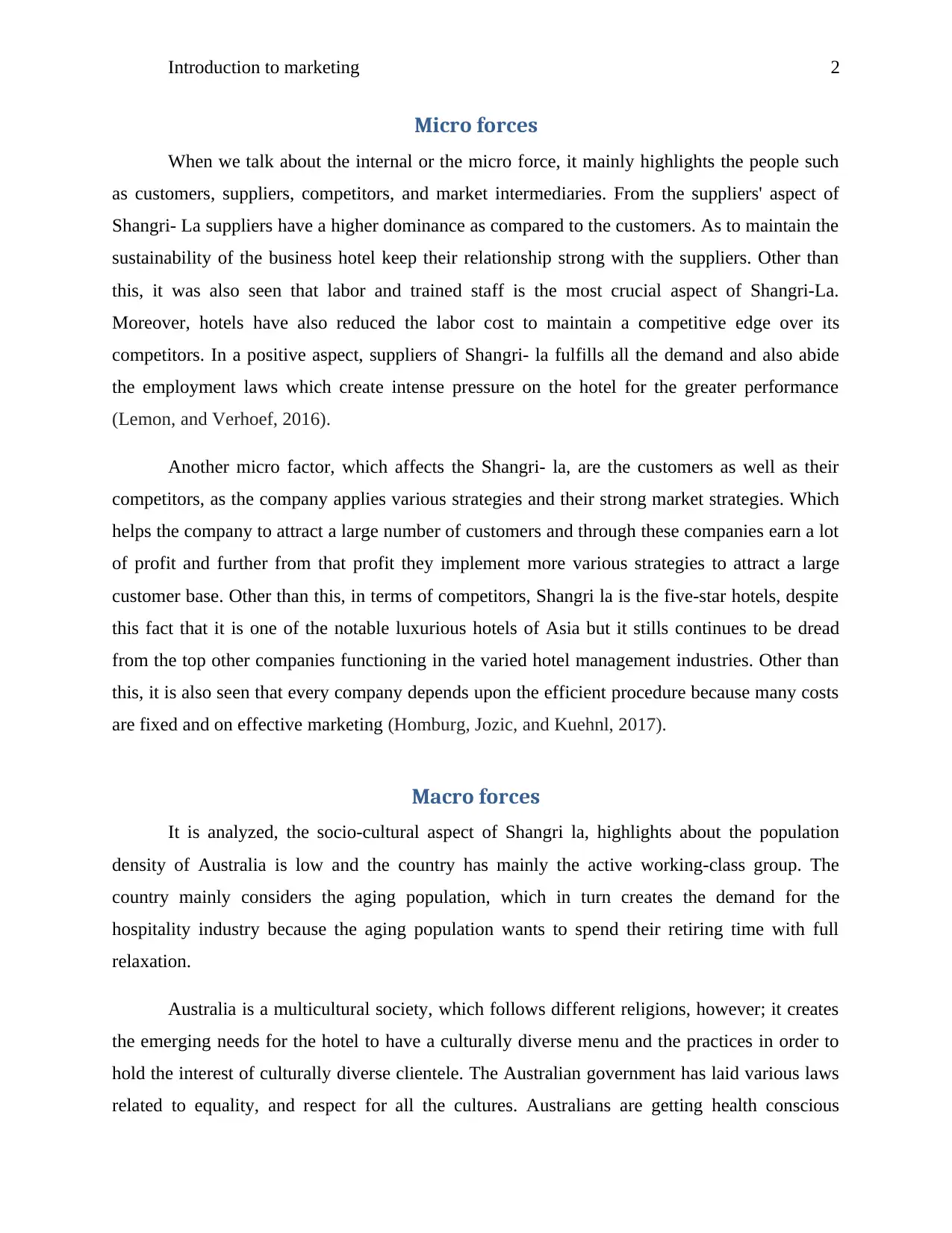
Introduction to marketing 2
Micro forces
When we talk about the internal or the micro force, it mainly highlights the people such
as customers, suppliers, competitors, and market intermediaries. From the suppliers' aspect of
Shangri- La suppliers have a higher dominance as compared to the customers. As to maintain the
sustainability of the business hotel keep their relationship strong with the suppliers. Other than
this, it was also seen that labor and trained staff is the most crucial aspect of Shangri-La.
Moreover, hotels have also reduced the labor cost to maintain a competitive edge over its
competitors. In a positive aspect, suppliers of Shangri- la fulfills all the demand and also abide
the employment laws which create intense pressure on the hotel for the greater performance
(Lemon, and Verhoef, 2016).
Another micro factor, which affects the Shangri- la, are the customers as well as their
competitors, as the company applies various strategies and their strong market strategies. Which
helps the company to attract a large number of customers and through these companies earn a lot
of profit and further from that profit they implement more various strategies to attract a large
customer base. Other than this, in terms of competitors, Shangri la is the five-star hotels, despite
this fact that it is one of the notable luxurious hotels of Asia but it stills continues to be dread
from the top other companies functioning in the varied hotel management industries. Other than
this, it is also seen that every company depends upon the efficient procedure because many costs
are fixed and on effective marketing (Homburg, Jozic, and Kuehnl, 2017).
Macro forces
It is analyzed, the socio-cultural aspect of Shangri la, highlights about the population
density of Australia is low and the country has mainly the active working-class group. The
country mainly considers the aging population, which in turn creates the demand for the
hospitality industry because the aging population wants to spend their retiring time with full
relaxation.
Australia is a multicultural society, which follows different religions, however; it creates
the emerging needs for the hotel to have a culturally diverse menu and the practices in order to
hold the interest of culturally diverse clientele. The Australian government has laid various laws
related to equality, and respect for all the cultures. Australians are getting health conscious
Micro forces
When we talk about the internal or the micro force, it mainly highlights the people such
as customers, suppliers, competitors, and market intermediaries. From the suppliers' aspect of
Shangri- La suppliers have a higher dominance as compared to the customers. As to maintain the
sustainability of the business hotel keep their relationship strong with the suppliers. Other than
this, it was also seen that labor and trained staff is the most crucial aspect of Shangri-La.
Moreover, hotels have also reduced the labor cost to maintain a competitive edge over its
competitors. In a positive aspect, suppliers of Shangri- la fulfills all the demand and also abide
the employment laws which create intense pressure on the hotel for the greater performance
(Lemon, and Verhoef, 2016).
Another micro factor, which affects the Shangri- la, are the customers as well as their
competitors, as the company applies various strategies and their strong market strategies. Which
helps the company to attract a large number of customers and through these companies earn a lot
of profit and further from that profit they implement more various strategies to attract a large
customer base. Other than this, in terms of competitors, Shangri la is the five-star hotels, despite
this fact that it is one of the notable luxurious hotels of Asia but it stills continues to be dread
from the top other companies functioning in the varied hotel management industries. Other than
this, it is also seen that every company depends upon the efficient procedure because many costs
are fixed and on effective marketing (Homburg, Jozic, and Kuehnl, 2017).
Macro forces
It is analyzed, the socio-cultural aspect of Shangri la, highlights about the population
density of Australia is low and the country has mainly the active working-class group. The
country mainly considers the aging population, which in turn creates the demand for the
hospitality industry because the aging population wants to spend their retiring time with full
relaxation.
Australia is a multicultural society, which follows different religions, however; it creates
the emerging needs for the hotel to have a culturally diverse menu and the practices in order to
hold the interest of culturally diverse clientele. The Australian government has laid various laws
related to equality, and respect for all the cultures. Australians are getting health conscious
⊘ This is a preview!⊘
Do you want full access?
Subscribe today to unlock all pages.

Trusted by 1+ million students worldwide
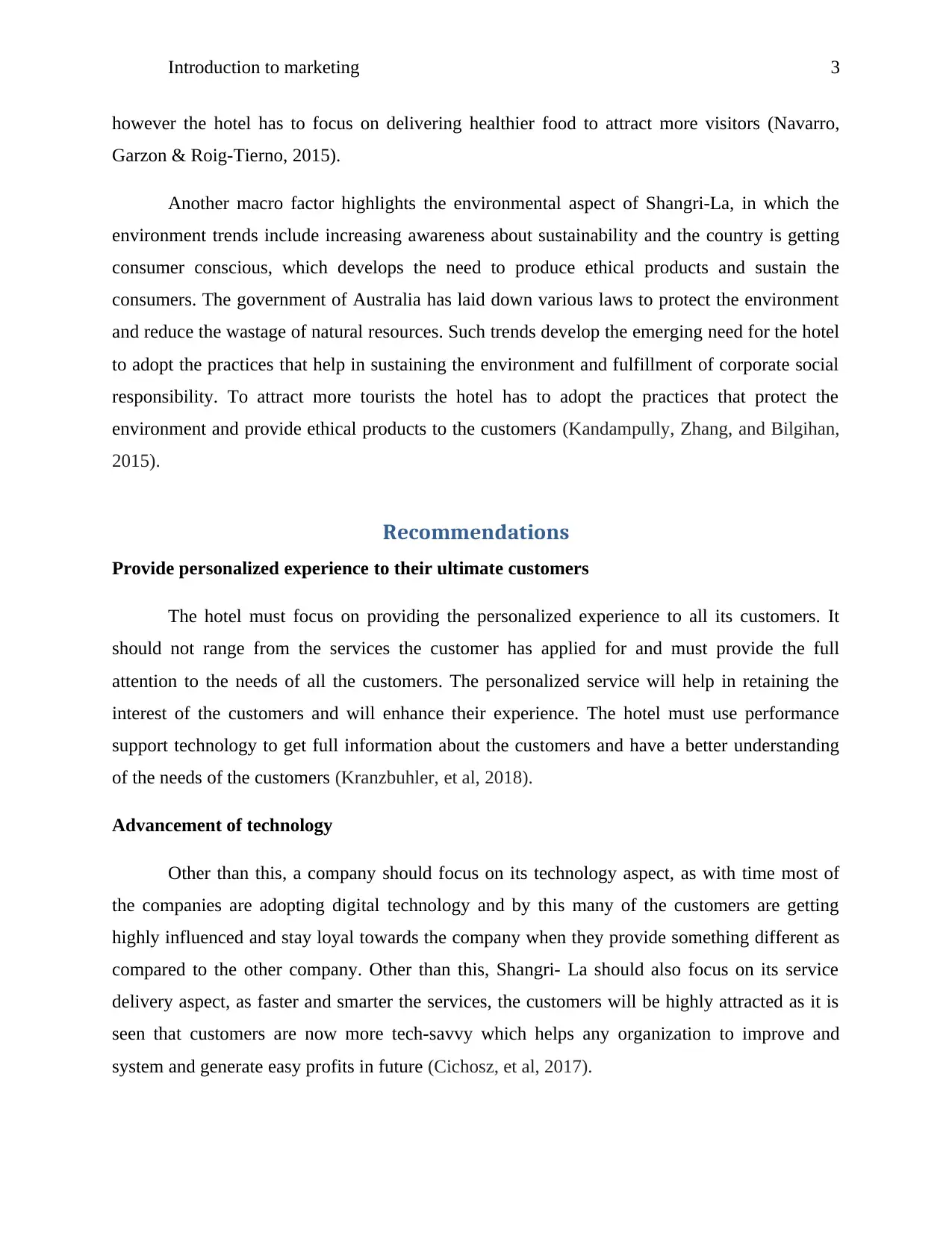
Introduction to marketing 3
however the hotel has to focus on delivering healthier food to attract more visitors (Navarro,
Garzon & Roig-Tierno, 2015).
Another macro factor highlights the environmental aspect of Shangri-La, in which the
environment trends include increasing awareness about sustainability and the country is getting
consumer conscious, which develops the need to produce ethical products and sustain the
consumers. The government of Australia has laid down various laws to protect the environment
and reduce the wastage of natural resources. Such trends develop the emerging need for the hotel
to adopt the practices that help in sustaining the environment and fulfillment of corporate social
responsibility. To attract more tourists the hotel has to adopt the practices that protect the
environment and provide ethical products to the customers (Kandampully, Zhang, and Bilgihan,
2015).
Recommendations
Provide personalized experience to their ultimate customers
The hotel must focus on providing the personalized experience to all its customers. It
should not range from the services the customer has applied for and must provide the full
attention to the needs of all the customers. The personalized service will help in retaining the
interest of the customers and will enhance their experience. The hotel must use performance
support technology to get full information about the customers and have a better understanding
of the needs of the customers (Kranzbuhler, et al, 2018).
Advancement of technology
Other than this, a company should focus on its technology aspect, as with time most of
the companies are adopting digital technology and by this many of the customers are getting
highly influenced and stay loyal towards the company when they provide something different as
compared to the other company. Other than this, Shangri- La should also focus on its service
delivery aspect, as faster and smarter the services, the customers will be highly attracted as it is
seen that customers are now more tech-savvy which helps any organization to improve and
system and generate easy profits in future (Cichosz, et al, 2017).
however the hotel has to focus on delivering healthier food to attract more visitors (Navarro,
Garzon & Roig-Tierno, 2015).
Another macro factor highlights the environmental aspect of Shangri-La, in which the
environment trends include increasing awareness about sustainability and the country is getting
consumer conscious, which develops the need to produce ethical products and sustain the
consumers. The government of Australia has laid down various laws to protect the environment
and reduce the wastage of natural resources. Such trends develop the emerging need for the hotel
to adopt the practices that help in sustaining the environment and fulfillment of corporate social
responsibility. To attract more tourists the hotel has to adopt the practices that protect the
environment and provide ethical products to the customers (Kandampully, Zhang, and Bilgihan,
2015).
Recommendations
Provide personalized experience to their ultimate customers
The hotel must focus on providing the personalized experience to all its customers. It
should not range from the services the customer has applied for and must provide the full
attention to the needs of all the customers. The personalized service will help in retaining the
interest of the customers and will enhance their experience. The hotel must use performance
support technology to get full information about the customers and have a better understanding
of the needs of the customers (Kranzbuhler, et al, 2018).
Advancement of technology
Other than this, a company should focus on its technology aspect, as with time most of
the companies are adopting digital technology and by this many of the customers are getting
highly influenced and stay loyal towards the company when they provide something different as
compared to the other company. Other than this, Shangri- La should also focus on its service
delivery aspect, as faster and smarter the services, the customers will be highly attracted as it is
seen that customers are now more tech-savvy which helps any organization to improve and
system and generate easy profits in future (Cichosz, et al, 2017).
Paraphrase This Document
Need a fresh take? Get an instant paraphrase of this document with our AI Paraphraser
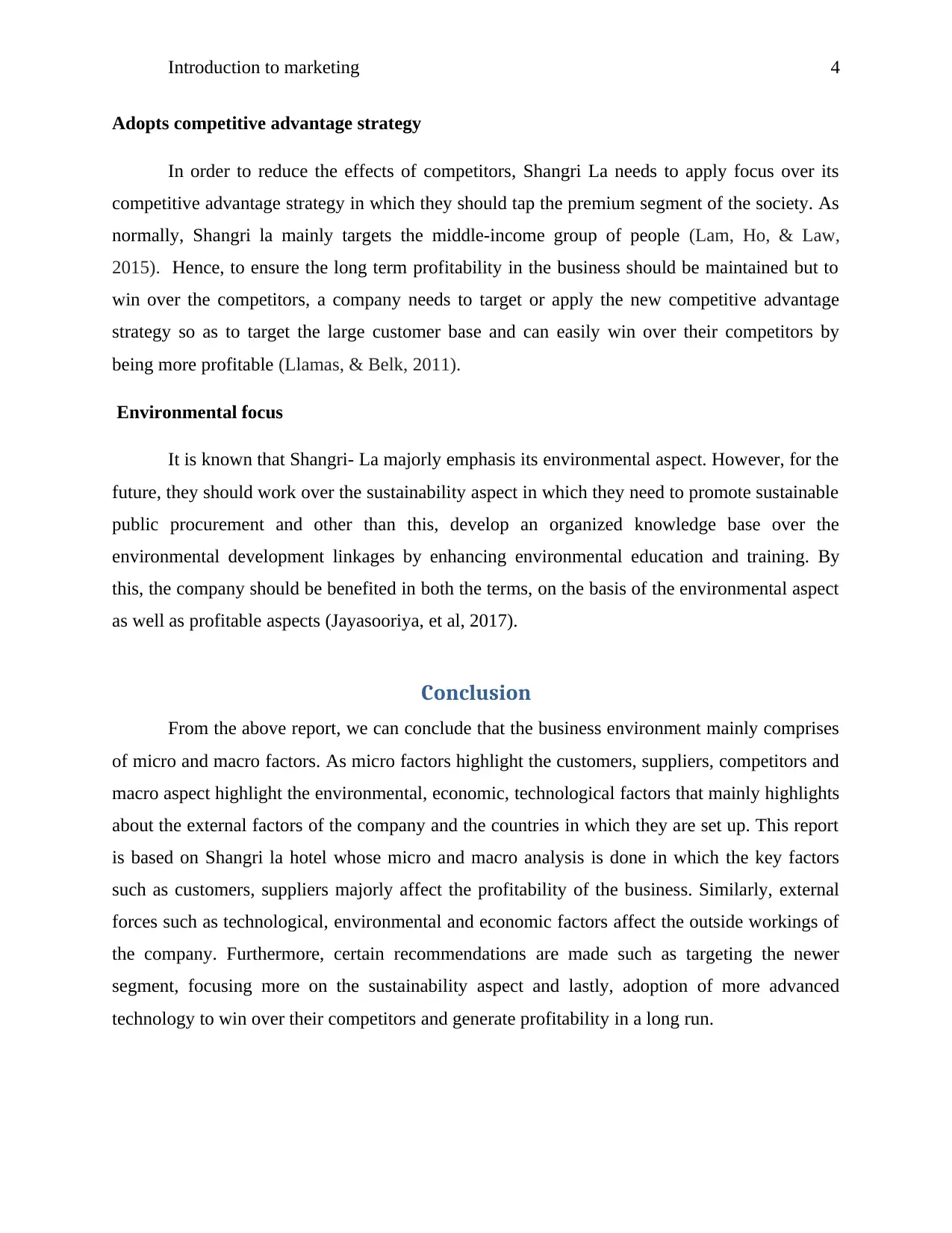
Introduction to marketing 4
Adopts competitive advantage strategy
In order to reduce the effects of competitors, Shangri La needs to apply focus over its
competitive advantage strategy in which they should tap the premium segment of the society. As
normally, Shangri la mainly targets the middle-income group of people (Lam, Ho, & Law,
2015). Hence, to ensure the long term profitability in the business should be maintained but to
win over the competitors, a company needs to target or apply the new competitive advantage
strategy so as to target the large customer base and can easily win over their competitors by
being more profitable (Llamas, & Belk, 2011).
Environmental focus
It is known that Shangri- La majorly emphasis its environmental aspect. However, for the
future, they should work over the sustainability aspect in which they need to promote sustainable
public procurement and other than this, develop an organized knowledge base over the
environmental development linkages by enhancing environmental education and training. By
this, the company should be benefited in both the terms, on the basis of the environmental aspect
as well as profitable aspects (Jayasooriya, et al, 2017).
Conclusion
From the above report, we can conclude that the business environment mainly comprises
of micro and macro factors. As micro factors highlight the customers, suppliers, competitors and
macro aspect highlight the environmental, economic, technological factors that mainly highlights
about the external factors of the company and the countries in which they are set up. This report
is based on Shangri la hotel whose micro and macro analysis is done in which the key factors
such as customers, suppliers majorly affect the profitability of the business. Similarly, external
forces such as technological, environmental and economic factors affect the outside workings of
the company. Furthermore, certain recommendations are made such as targeting the newer
segment, focusing more on the sustainability aspect and lastly, adoption of more advanced
technology to win over their competitors and generate profitability in a long run.
Adopts competitive advantage strategy
In order to reduce the effects of competitors, Shangri La needs to apply focus over its
competitive advantage strategy in which they should tap the premium segment of the society. As
normally, Shangri la mainly targets the middle-income group of people (Lam, Ho, & Law,
2015). Hence, to ensure the long term profitability in the business should be maintained but to
win over the competitors, a company needs to target or apply the new competitive advantage
strategy so as to target the large customer base and can easily win over their competitors by
being more profitable (Llamas, & Belk, 2011).
Environmental focus
It is known that Shangri- La majorly emphasis its environmental aspect. However, for the
future, they should work over the sustainability aspect in which they need to promote sustainable
public procurement and other than this, develop an organized knowledge base over the
environmental development linkages by enhancing environmental education and training. By
this, the company should be benefited in both the terms, on the basis of the environmental aspect
as well as profitable aspects (Jayasooriya, et al, 2017).
Conclusion
From the above report, we can conclude that the business environment mainly comprises
of micro and macro factors. As micro factors highlight the customers, suppliers, competitors and
macro aspect highlight the environmental, economic, technological factors that mainly highlights
about the external factors of the company and the countries in which they are set up. This report
is based on Shangri la hotel whose micro and macro analysis is done in which the key factors
such as customers, suppliers majorly affect the profitability of the business. Similarly, external
forces such as technological, environmental and economic factors affect the outside workings of
the company. Furthermore, certain recommendations are made such as targeting the newer
segment, focusing more on the sustainability aspect and lastly, adoption of more advanced
technology to win over their competitors and generate profitability in a long run.
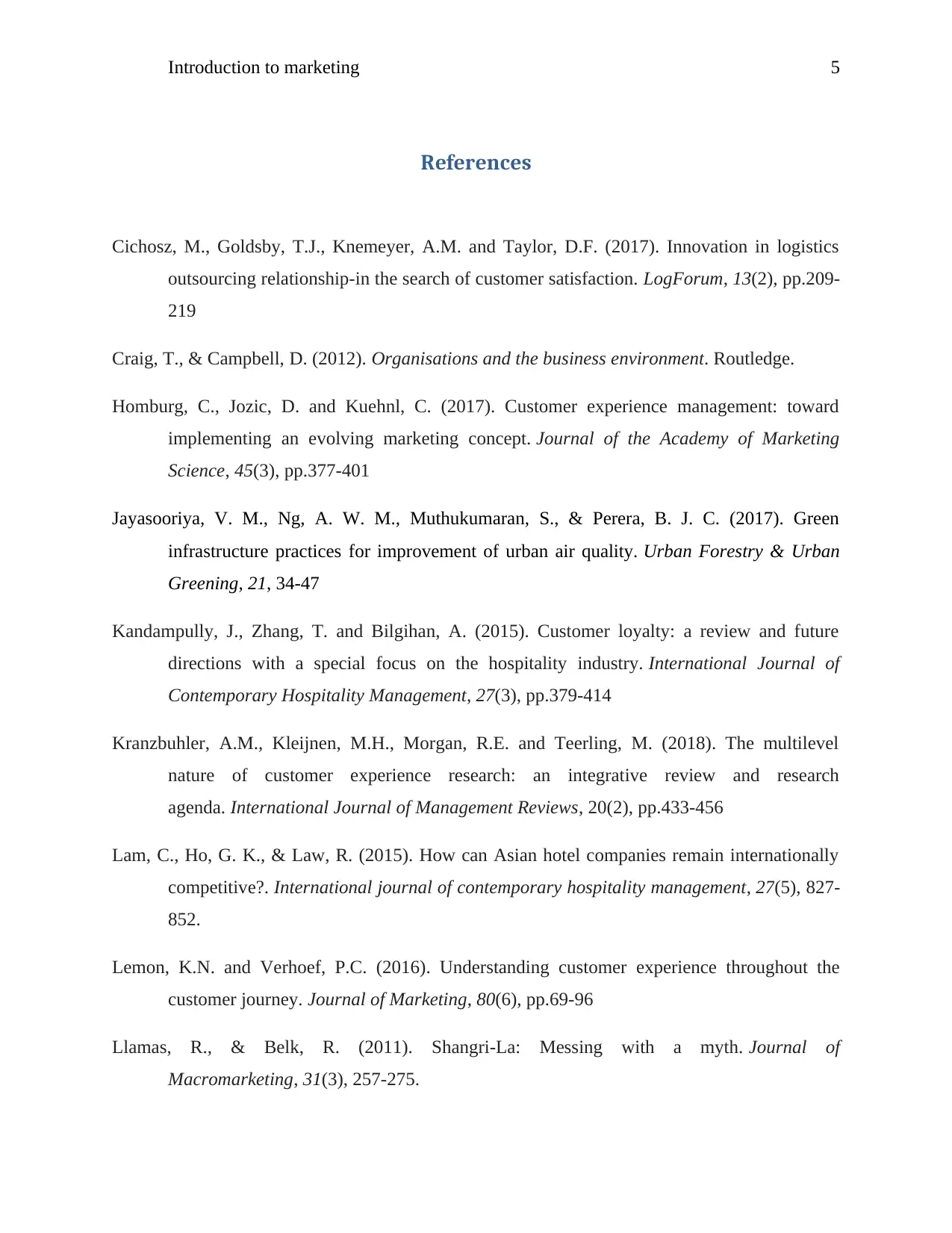
Introduction to marketing 5
References
Cichosz, M., Goldsby, T.J., Knemeyer, A.M. and Taylor, D.F. (2017). Innovation in logistics
outsourcing relationship-in the search of customer satisfaction. LogForum, 13(2), pp.209-
219
Craig, T., & Campbell, D. (2012). Organisations and the business environment. Routledge.
Homburg, C., Jozic, D. and Kuehnl, C. (2017). Customer experience management: toward
implementing an evolving marketing concept. Journal of the Academy of Marketing
Science, 45(3), pp.377-401
Jayasooriya, V. M., Ng, A. W. M., Muthukumaran, S., & Perera, B. J. C. (2017). Green
infrastructure practices for improvement of urban air quality. Urban Forestry & Urban
Greening, 21, 34-47
Kandampully, J., Zhang, T. and Bilgihan, A. (2015). Customer loyalty: a review and future
directions with a special focus on the hospitality industry. International Journal of
Contemporary Hospitality Management, 27(3), pp.379-414
Kranzbuhler, A.M., Kleijnen, M.H., Morgan, R.E. and Teerling, M. (2018). The multilevel
nature of customer experience research: an integrative review and research
agenda. International Journal of Management Reviews, 20(2), pp.433-456
Lam, C., Ho, G. K., & Law, R. (2015). How can Asian hotel companies remain internationally
competitive?. International journal of contemporary hospitality management, 27(5), 827-
852.
Lemon, K.N. and Verhoef, P.C. (2016). Understanding customer experience throughout the
customer journey. Journal of Marketing, 80(6), pp.69-96
Llamas, R., & Belk, R. (2011). Shangri-La: Messing with a myth. Journal of
Macromarketing, 31(3), 257-275.
References
Cichosz, M., Goldsby, T.J., Knemeyer, A.M. and Taylor, D.F. (2017). Innovation in logistics
outsourcing relationship-in the search of customer satisfaction. LogForum, 13(2), pp.209-
219
Craig, T., & Campbell, D. (2012). Organisations and the business environment. Routledge.
Homburg, C., Jozic, D. and Kuehnl, C. (2017). Customer experience management: toward
implementing an evolving marketing concept. Journal of the Academy of Marketing
Science, 45(3), pp.377-401
Jayasooriya, V. M., Ng, A. W. M., Muthukumaran, S., & Perera, B. J. C. (2017). Green
infrastructure practices for improvement of urban air quality. Urban Forestry & Urban
Greening, 21, 34-47
Kandampully, J., Zhang, T. and Bilgihan, A. (2015). Customer loyalty: a review and future
directions with a special focus on the hospitality industry. International Journal of
Contemporary Hospitality Management, 27(3), pp.379-414
Kranzbuhler, A.M., Kleijnen, M.H., Morgan, R.E. and Teerling, M. (2018). The multilevel
nature of customer experience research: an integrative review and research
agenda. International Journal of Management Reviews, 20(2), pp.433-456
Lam, C., Ho, G. K., & Law, R. (2015). How can Asian hotel companies remain internationally
competitive?. International journal of contemporary hospitality management, 27(5), 827-
852.
Lemon, K.N. and Verhoef, P.C. (2016). Understanding customer experience throughout the
customer journey. Journal of Marketing, 80(6), pp.69-96
Llamas, R., & Belk, R. (2011). Shangri-La: Messing with a myth. Journal of
Macromarketing, 31(3), 257-275.
⊘ This is a preview!⊘
Do you want full access?
Subscribe today to unlock all pages.

Trusted by 1+ million students worldwide
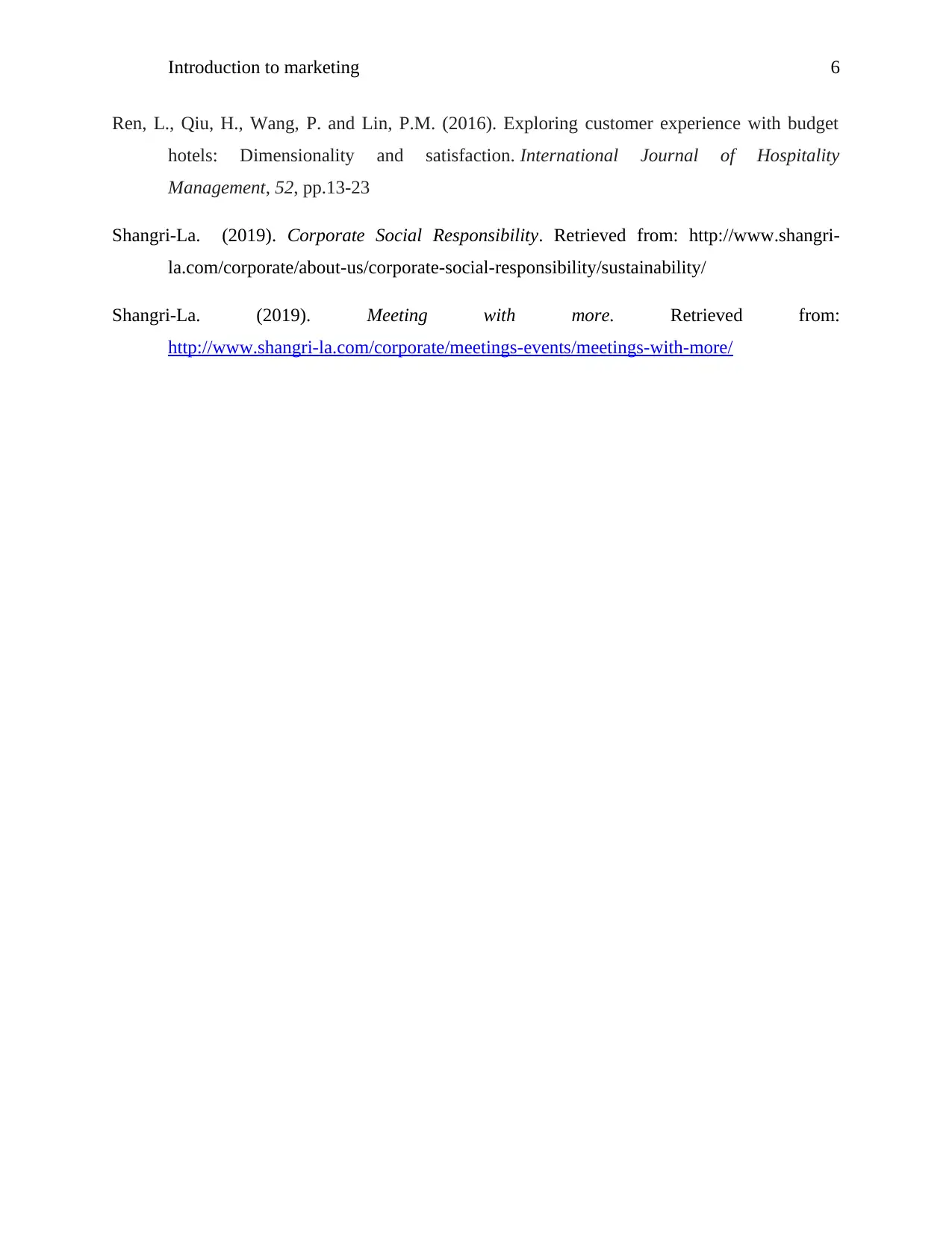
Introduction to marketing 6
Ren, L., Qiu, H., Wang, P. and Lin, P.M. (2016). Exploring customer experience with budget
hotels: Dimensionality and satisfaction. International Journal of Hospitality
Management, 52, pp.13-23
Shangri-La. (2019). Corporate Social Responsibility. Retrieved from: http://www.shangri-
la.com/corporate/about-us/corporate-social-responsibility/sustainability/
Shangri-La. (2019). Meeting with more. Retrieved from:
http://www.shangri-la.com/corporate/meetings-events/meetings-with-more/
Ren, L., Qiu, H., Wang, P. and Lin, P.M. (2016). Exploring customer experience with budget
hotels: Dimensionality and satisfaction. International Journal of Hospitality
Management, 52, pp.13-23
Shangri-La. (2019). Corporate Social Responsibility. Retrieved from: http://www.shangri-
la.com/corporate/about-us/corporate-social-responsibility/sustainability/
Shangri-La. (2019). Meeting with more. Retrieved from:
http://www.shangri-la.com/corporate/meetings-events/meetings-with-more/
1 out of 7
Related Documents
Your All-in-One AI-Powered Toolkit for Academic Success.
+13062052269
info@desklib.com
Available 24*7 on WhatsApp / Email
![[object Object]](/_next/static/media/star-bottom.7253800d.svg)
Unlock your academic potential
Copyright © 2020–2025 A2Z Services. All Rights Reserved. Developed and managed by ZUCOL.





